BABETTE’S YEAST
Bread, leavened and heavenly
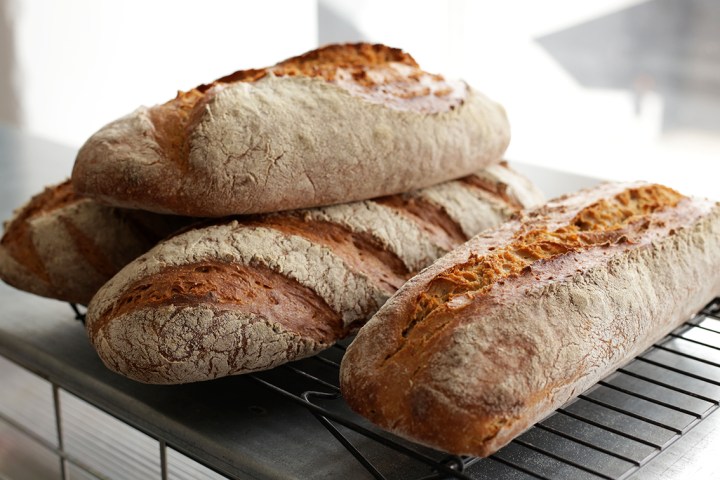
Getting friendly with one’s bread is a perk while making and baking it personally – and there can be important matters of economics worth pondering while you have clingy going-to-be-dough all over the hands and wrists.
It’s the very first stage, after adding the salt, dried yeast and water to a really good flour such as Eureka Mills, even if it is “white”, easy to get at any Pick n Pay. (If you’re going to bake bread I reckon there is no point in using bleached and leached flour. I’m sure you do want it to have some inherent goodness within): It’s not strictly necessary to take a huge amount of time communing with the would-be dough but it can feel like the beginning of a personal relationship, if a slightly clingy one at that stage. The main idea is to gather all the dry flour, with all its stickiness, into what is likely to become a ball at a later stage.
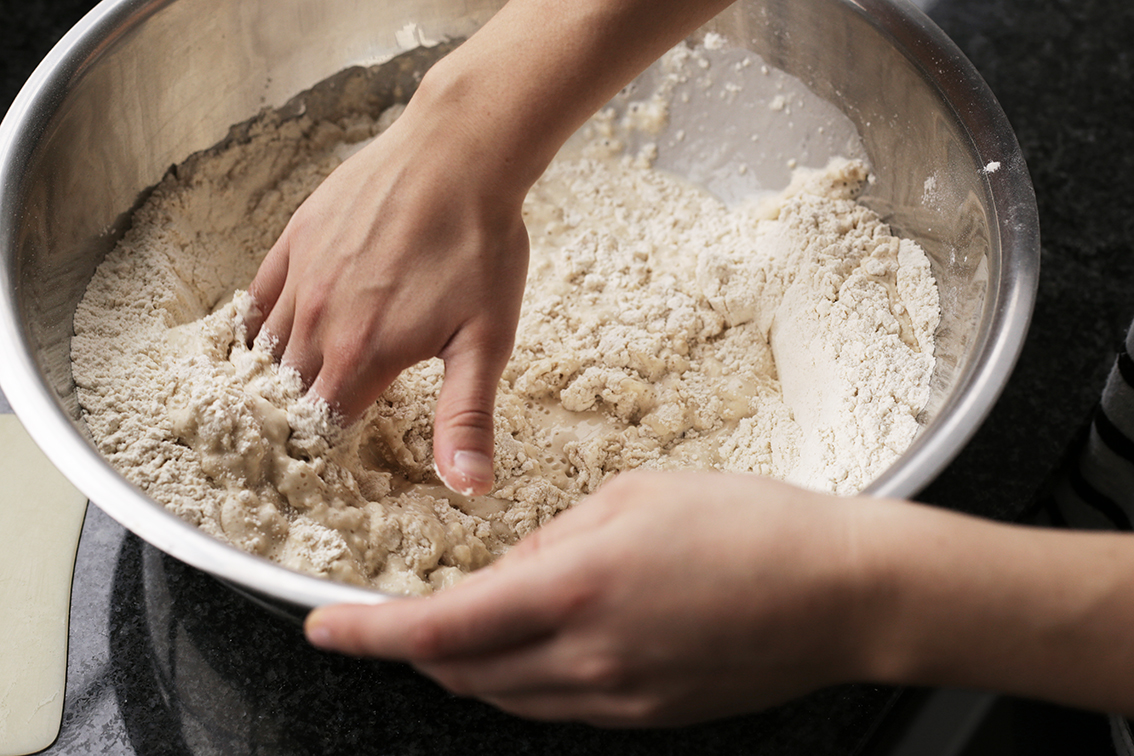
Hand-mixing dry and wet ingredients because it’s hard to overmix by hand. Photo: Karené Wedekind
I’d come across an interesting master baker called Babette Kourelos when I found her making dark and steamy, beguiling-smelling loaves on an open-plan first floor, shared with architects in Maboneng. After she moved, I had to follow her loaves, some of which are supplied to a restaurant with deli, near me. So it was a meaningful coincidence when I attended a pop-up bread class of hers at the very spot where I first smelt those delicious loaves I saw her knocking, listening to their readiness as food. I do make bread of various sorts but I knew it could be very much improved by a master baker. The class included first-timers, second-timers and a few old hands that can always do with some more hand- and dough-holding.
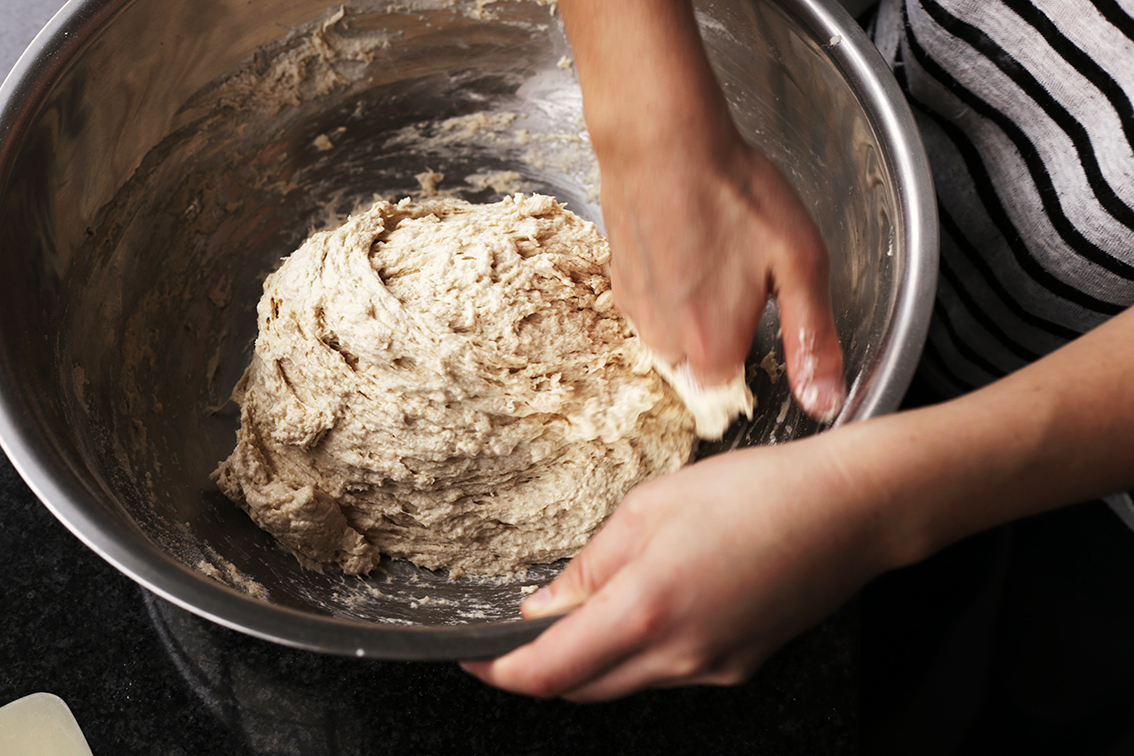
Getting all the dry bits included – already the jagged lines in the dough indicate the very first signs of some gluten development. Photo: Karené Wedekind
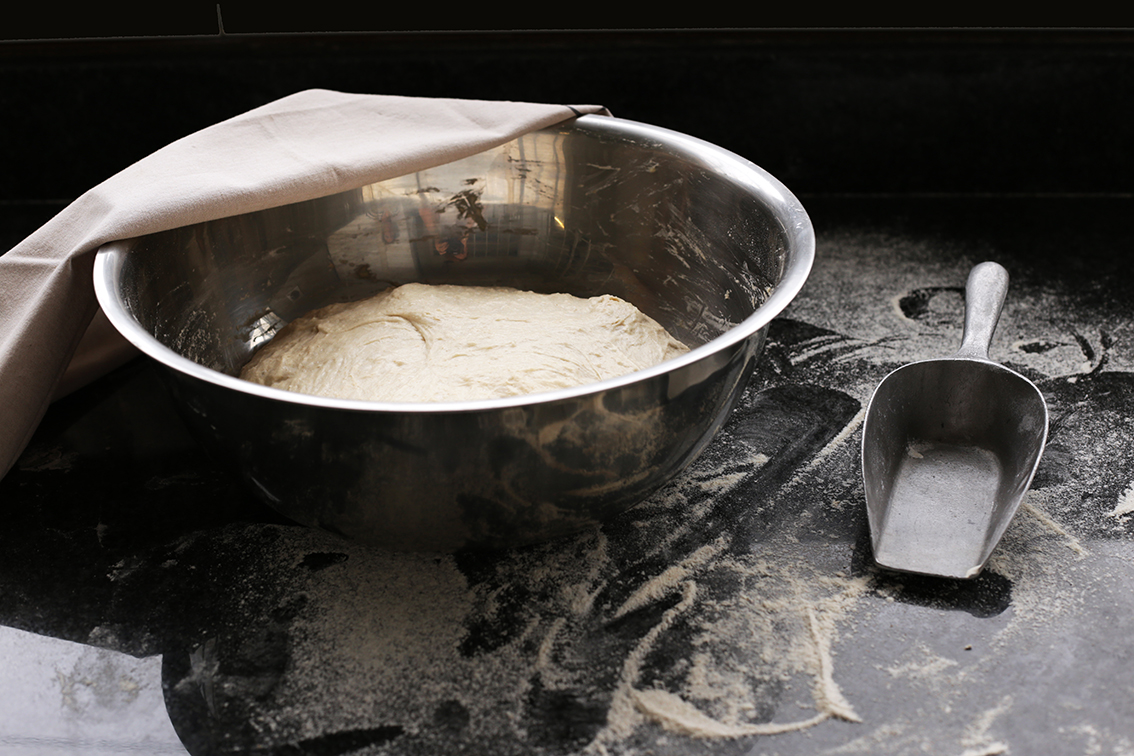
After undergoing its bulk fermentation. Photo: Karené Wedekind
It was almost too appropriate that Babette would hear the answer to a question I often get: “Is there anything you don’t eat?” People often become raucous when I tell them. I do and will eat everything. I’m just not madly keen on white food. When the hilarity dies down, someone inevitably goes on, “So why just white?” It sounds faintly accusatory. I didn’t know the real answer for a long time. That came to me as I watched a friend mixing a white sauce, feeling increasingly uncomfortable. I realised it was all about the dread of uncooked white flour, just then remembering watching a man putting up wallpaper when I was a kid and the white, grim smelling paste he was smearing onto it was, as he said, a mixture of flour and water. I gag at both memories.
Babette smiled, her hands covered with not-so-white flour.
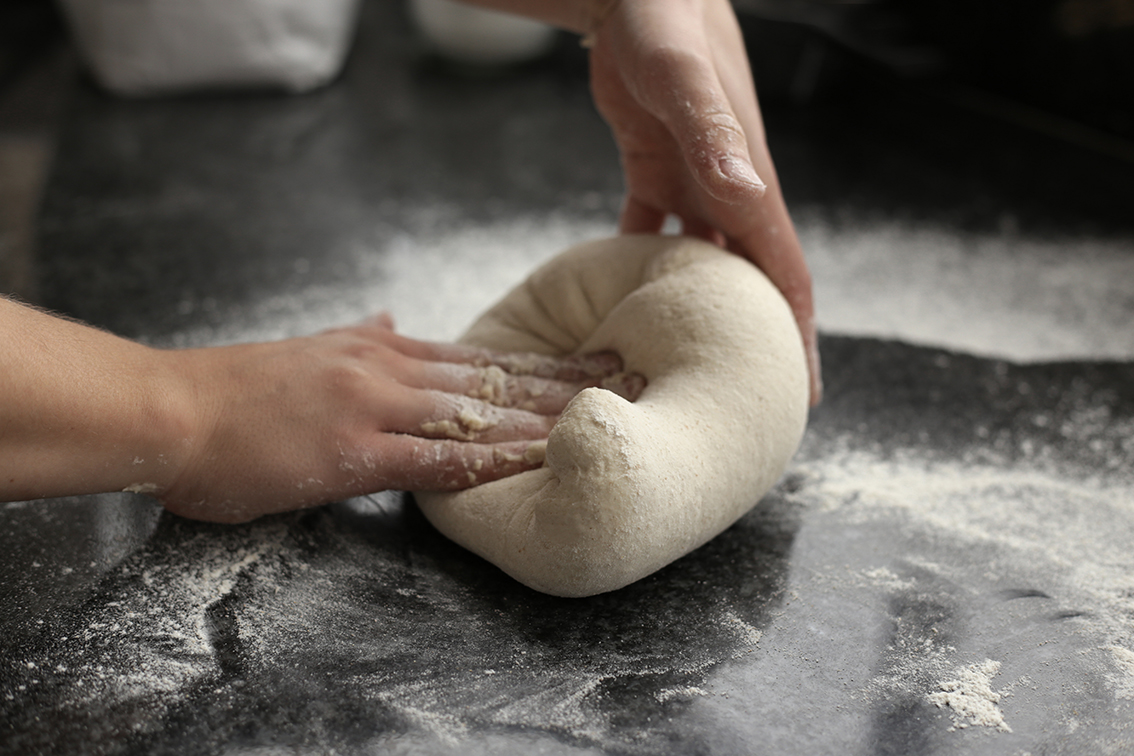
Folding in the edges. Photo: Karené Wedekind

Final shaping of the dough. Photo: Karené Wedekind

Testing the firmness and shaping a round loaf. Photo: Karené Wedekind
Lunch was going to be a table picnic, of her bread, already baking, with lots of colourful Mediterranean dips, cheeses, meats and olives. Stationed at the top of the steps to the baking floor was an Ethiopian coffee maker called Solomon and his barista trainees. They were not conducting the usual ceremony but making the class’s coffees, even cappuccinos, throughout the making, the baking and the in-between hours, using Ethiopian just-roasted beans. Clustered on our baking class table for fore-lunch purposes were Babette-baked buttermilk rusks, fruit and nuts, including dishes of kolo, the roasted barley, chickpea and groundnut mixture that Ethiopians snack on with coffee.
After an hour, we retackled our dough. People were speaking about their dough being pliant but I found it had begun to fight back at that stage. It was no longer a submissive squelch. The fermentation was changing its character and my relationship with the dough was becoming more one-to-one. We all pinched and turned our bowls of dough around and around, working it into belly-rounds.
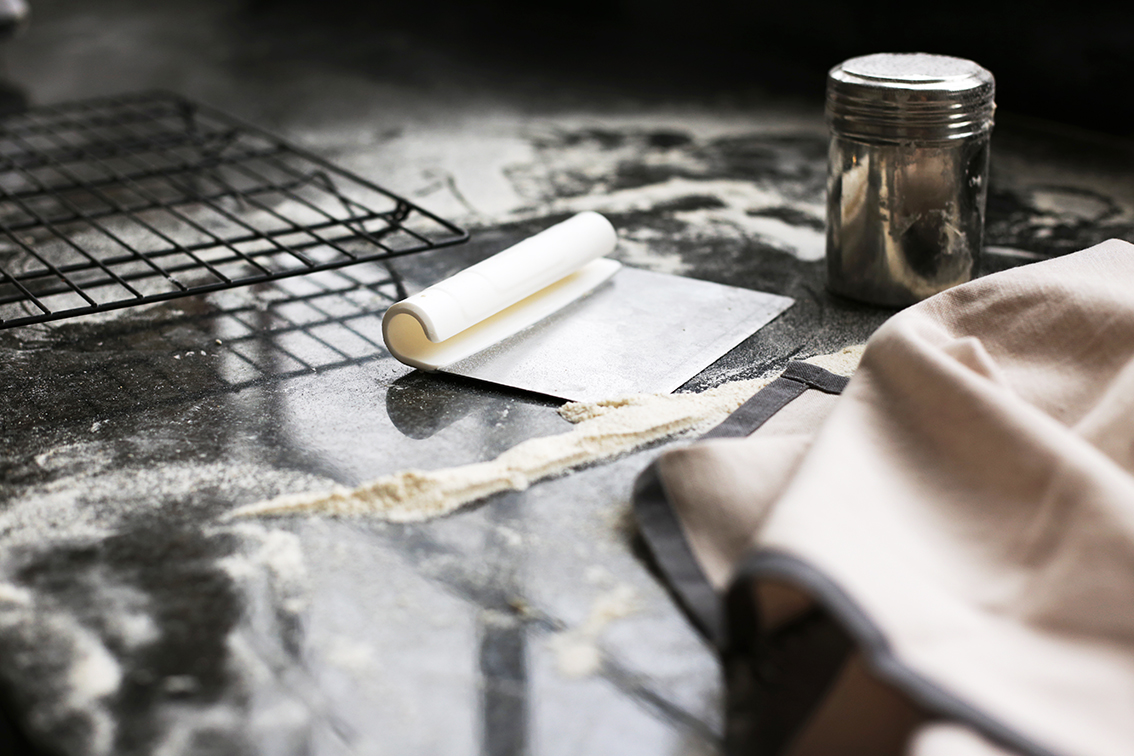
Some of the baker’s tools such as a dough cutter, a flour shaker, a proofing cloth and cooling rack. Photo: Karené Wedekind
We broke for that lunch where we used only rippings of Babette’s own bread as trenchers of a kind, instead of using utensils. How far her loaves and our developing bread was from that puffy stuff people buy, the pathetic pale cuboids that cannot possibly contain a single natural nutrient. Bread can only be a staff of life if it sustains living for people. Yet people buy those fluffy loaves that one can balance on a finger and they eat that stuff, if “eat” is even the right word.
Somewhere along the breadline, people forgot about nutrition and started consuming bread for pallor. All those strong ryes and heavy black loaves shovelled out of ovens like bricks kept people fed with nutrition, people who, otherwise, often only had water. But, out of the corners of their eyes, the people were watching wealthier merchants eating paler loaves of “refined” flours. Pallor equalled rank for the reason that it was more expensive and not quite as readily available. It cost to go to the trouble of removing nutrition from flour, to get it pallid and uninteresting from a sustenance perspective. What would the wealthy need of sustenance? Yes, “refined” meant removing the nutritious parts, then finely milling the rest so that no real food remained in the flours. When you strip flour, now done chemically, you also strip the bread of its taste.
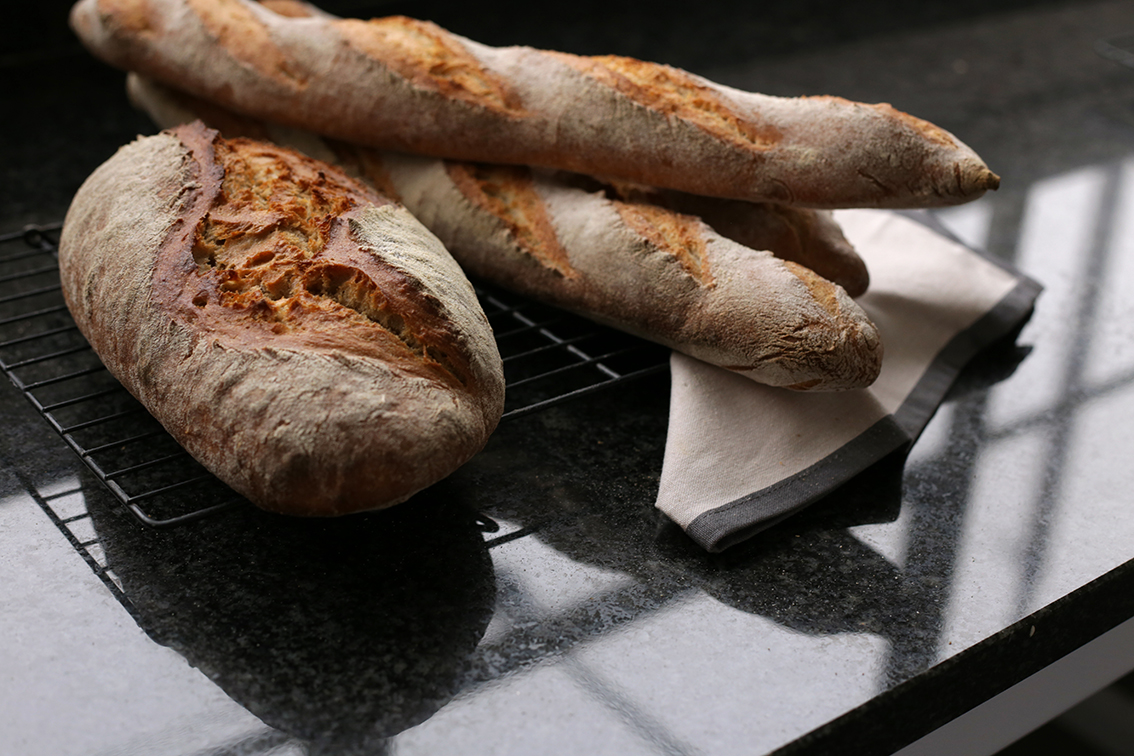
Delicious loaves. Photo: Karené Wedekind
Bread was soon to stop being bread. Real bread could be a staple in any person’s diet. Bread had meant so much more than a loaf-shaped thing of bleached cottonwool that people actually pay for and even worry that they may not be able to afford. There is a mighty sin in this somewhere.
Across many cultures, the dark barleys and ryes became food for the poor, thank heavens. It cost more to grow the paler wheats and still more to remove anything nutritive that interfered with the pale looks of the riches’ loaves. There were even two different bakers’ guilds up till the 17th century, one for brown breads and one for white. Of course, the white bread guild was regarded as superior.
Musing time gave way to another session of bonding time with my smooth-skinned leavening – and livening – bread dough, patting and thomping and then folding the edges over and into the bread, around and around, one of the things I’d not done before when making my bread and making for more air inside. I was sure I heard my dough squeak at me.
About an hour and a half of more peace time later, we were in Babette’s ovens room, dividing the doughs to make two or even more loaves of whatever shape, apiece. Some people plaited theirs. Some drew patterns on the tops, some made rounds, some ovals. Some got theirs ready for baking in pots. I wanted something like two short logs, so I twisted mine. I could feel and see it squirming recalcitrantly to untwist itself. Babette did a very master-bakery thing there and trapped the shapes in folds of linen, a long, French proving cloth, with the loaves great and small waiting for their baking.
When baking the loaves, Babette sprayed the insides of the ovens with water to steam the dough better, something I’ve seen done by tossing ice cubs into the oven but never done personally.
My bread emerged with both logs long, having merged into a T-shape, which I separated proudly, the crusts impressively dark and the insides tender and a natural, health-food beige, having used “white” stoneground flour, unbleached and unstripped, of course. They were warm and gloriously aromatic evidence that bread can be better, more filling, and costing about the same as one-and-a-half government-regulated-size cuboids of pale puff-nothing.
They were my enormous, nutritious staves of life. DM
Babette Kourelos www.babettesbread.co.za [email protected] 084 516 3014





 Become an Insider
Become an Insider